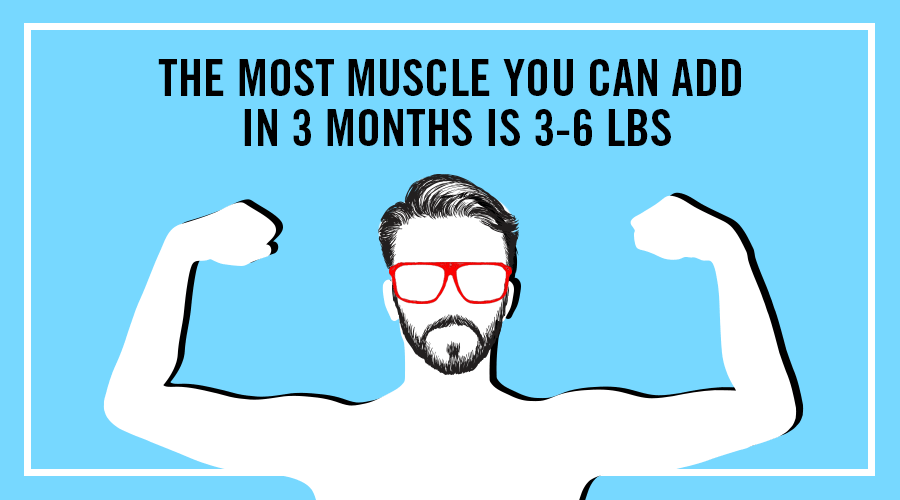It seems like every time spring training starts, guys who left the field worn down at the end of September come back in mid-February super-ripped, with tons of new muscle — Red Sox outfielder Andrew Benintendi, for example, added an extra 20 pounds to his frame over this last winter. Same for the Mets’ Yoenis Cespedes, whose newly bulging frame ESPN’s Buster Olney can’t stop talking about on the Baseball Tonight podcast: HE’S BECOME SUCH A MONSTER IN SUCH A SHORT AMOUNT OF TIME. HE’S JUST HUGE. SO, SO, SO HUGE.
https://www.youtube.com/watch?v=s3mdEI5OpPc
But does this mean the average guy, eyeing a calendar and seeing it’s three months till his next beach vacation, can do the same? Nutritionists often warn that it’s not safe to lose more than a couple pounds a week when dieting, but what about when you’re trying to put on weight?
The Amount of Muscle You Can Add in… One Week
Bad news, last-minute gym-goers: Not too much is going to happen to your body in the first week of working out. If you’ve waited until seven days before spring break to nix the fast food and start pumping iron, it’s basically too late, according to health, nutrition and lifestyle consultant Michael Kuhn, founder of Mike the Caveman Consulting. He says that you can expect to gain “about 0.2 to 0.25 pounds [of muscle] at most” in the first week. More depressingly for on-again, off-again exercisers, that applies as much to those who’ve taken some time away from the gym as it does to first-timers.
The simple reason for this is that building muscle takes time. “The protein turnover rate — that is, the breaking down of damaged muscle proteins and the creation of new and stronger ones [which is what you’re doing when you gain muscle] — is the time limiter,” explains Carolyn Dean, a member of the Medical Advisory Board at the Nutritional Magnesium Association.
This doesn’t mean you should be put off, though: While the first week will be slow going, with little in the way of visible results, it has the benefit of getting you into an established routine, setting you up for bigger rewards to come.
The Amount of Muscle You Can Add in… One Month
If you’ve put things off until a month before your deadline — say, you’ve decided you’ve got to be Wolverine for an upcoming Con but only have four weeks to get in shape — you’ll be relieved to hear that you can actually see some decent results in that time period.
“Things will start to pick up after the second week — from that point, you could probably expect 0.5 pounds of muscle gained per week,” says Kuhn. As for the full first month: “You can expect at most to gain about two pounds of muscle, if you’re really dialed in,” he adds. And by “dialed in,” he means not just hitting the gym, but eating the right food and getting enough sleep.
“As a general rule, the key to successful muscle growth is that muscle protein synthesis [the creation of new muscle] must exceed muscle protein breakdown [the shedding of old muscle],” says Dean. To accomplish this, she says it’s vital to eat a balanced diet that includes both protein and carbohydrates, as well as getting enough rest.
In other words, despite what most people think, the gym isn’t really where your muscles grow — the process of tissue repair that makes your muscles bigger actually happens after you work out, when you’re at rest, so be sure to hit the sack early if you’re trying to bulk up.
For exercise, Kuhn recommends doing lots of heavy resistance training. “In terms of pure muscle growth, you want to be on the higher end with reps, about 8 to 15 reps per set.” He advises doing a lot of pushing exercises, like bench presses and push-ups, as well as pulling exercises like pull-ups and curls. Don’t overdo it, though: Three days a week of this type of workout should be plenty.
Diet-wise, he recommends “lots of protein and fats to maintain your hormone levels.” High protein foods include fish, beef and chicken. But don’t stop there — fat is also really important. “A big problem I run into is that people don’t get enough fat,” he explains. Sadly, this doesn’t mean shoving a bunch of greasy burgers into your mouth, but quality fats like coconut oils, avocado oil and eggs (especially the yolks).
The Amount of Muscle You Can Add in… Three Months
By doing the math, you can figure out that two pounds of muscle per month must mean you can pack on at least a good six pounds in 90 days, right? Well, while that’s not an impossible goal, Kuhn likes to be more conservative. “Three to six pounds max is reasonable, but by this time you may begin to see muscle-building slow down,” he says. This is because your connective tissue — like joints and ligaments — can only grow so much at once — and it’s why so many fitness “challenges” are eight weeks or twelve weeks: You won’t see such startling results after that point.

Now, it is possible for your body can grow more muscle than this, but it requires you to change up your tactics for at least a month. “After two months, I recommend switching things up from muscle-building to more strength-based exercises, with lower reps and higher weight,” says Kuhn. “If you did 10 pounds at 10 reps in the muscle-building phase, you might do five reps at 20 pounds for the strength-based phase.”
This is what’s referred to as “progressive overload,” a technique designed to prepare you to lift more weight in future workouts. You won’t see your muscles grow as much, but when you return to the muscle-building workouts, you’ll be able to lift more and see greater results. For an ongoing workout, eight weeks of muscle-building followed by four weeks of strength-building is a good pattern to follow.
The Amount of Muscle You Can Add… If You’re a Star Athlete
All in all, though, the human body can only create so much muscle within a given time frame, and Kuhn believes that even just one pound of muscle per month is a practical goal for most men. Which, of course, raises a question: How is it possible for an athlete to show up to spring training with an extra 20 pounds of muscle?
The short answer: It isn’t. Due to their constant training and the edge that gives them, athletes may be able to add up to 10 pounds of real muscle in 90 days, but that’s it. “A lot of those numbers are inflated,” says Kuhn. “You aren’t going to gain that much weight in pure muscle — much of that will be fat and water weight as well.”
Despite how disappointing this sounds, it’s actually good news for you — six pounds of muscle doesn’t sound like a lot, but with the right diet, you’ll be putting on closer to 12 pounds of actual bulk.
So take your “before” pictures now, and start pumping.

